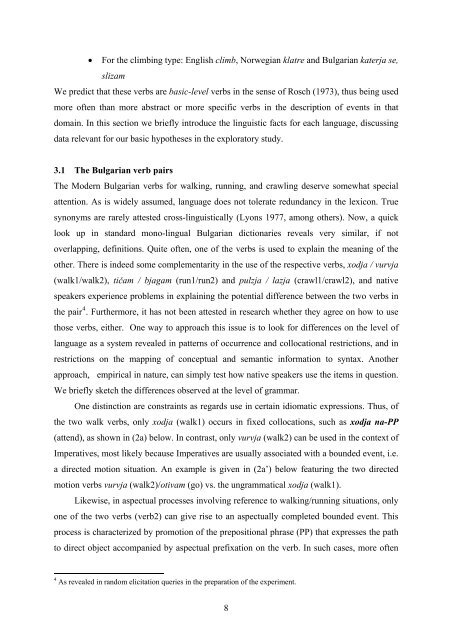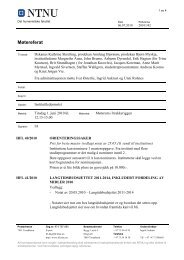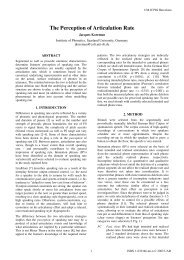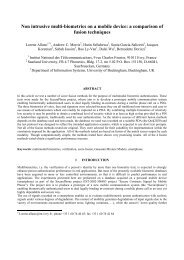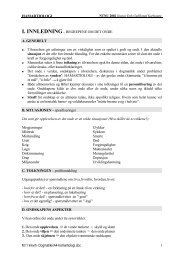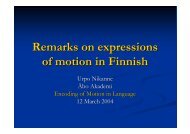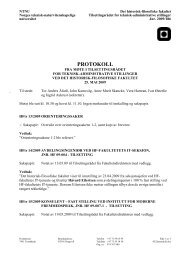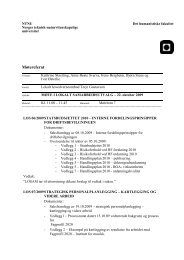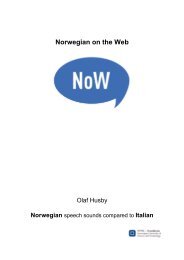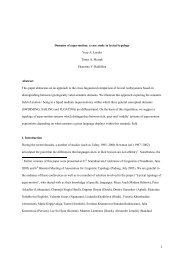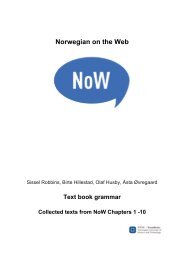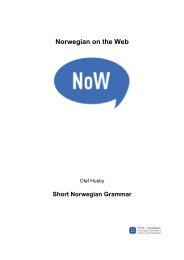In press: In: Dimitrova-Vulchanova, M - NTNU
In press: In: Dimitrova-Vulchanova, M - NTNU
In press: In: Dimitrova-Vulchanova, M - NTNU
You also want an ePaper? Increase the reach of your titles
YUMPU automatically turns print PDFs into web optimized ePapers that Google loves.
• For the climbing type: English climb, Norwegian klatre and Bulgarian katerja se,<br />
slizam<br />
We predict that these verbs are basic-level verbs in the sense of Rosch (1973), thus being used<br />
more often than more abstract or more specific verbs in the description of events in that<br />
domain. <strong>In</strong> this section we briefly introduce the linguistic facts for each language, discussing<br />
data relevant for our basic hypotheses in the exploratory study.<br />
3.1 The Bulgarian verb pairs<br />
The Modern Bulgarian verbs for walking, running, and crawling deserve somewhat special<br />
attention. As is widely assumed, language does not tolerate redundancy in the lexicon. True<br />
synonyms are rarely attested cross-linguistically (Lyons 1977, among others). Now, a quick<br />
look up in standard mono-lingual Bulgarian dictionaries reveals very similar, if not<br />
overlapping, definitions. Quite often, one of the verbs is used to explain the meaning of the<br />
other. There is indeed some complementarity in the use of the respective verbs, xodja / vurvja<br />
(walk1/walk2), tičam / bjagam (run1/run2) and pulzja / lazja (crawl1/crawl2), and native<br />
speakers experience problems in explaining the potential difference between the two verbs in<br />
the pair 4 . Furthermore, it has not been attested in research whether they agree on how to use<br />
those verbs, either. One way to approach this issue is to look for differences on the level of<br />
language as a system revealed in patterns of occurrence and collocational restrictions, and in<br />
restrictions on the mapping of conceptual and semantic information to syntax. Another<br />
approach, empirical in nature, can simply test how native speakers use the items in question.<br />
We briefly sketch the differences observed at the level of grammar.<br />
One distinction are constraints as regards use in certain idiomatic ex<strong>press</strong>ions. Thus, of<br />
the two walk verbs, only xodja (walk1) occurs in fixed collocations, such as xodja na-PP<br />
(attend), as shown in (2a) below. <strong>In</strong> contrast, only vurvja (walk2) can be used in the context of<br />
Imperatives, most likely because Imperatives are usually associated with a bounded event, i.e.<br />
a directed motion situation. An example is given in (2a’) below featuring the two directed<br />
motion verbs vurvja (walk2)/otivam (go) vs. the ungrammatical xodja (walk1).<br />
Likewise, in aspectual processes involving reference to walking/running situations, only<br />
one of the two verbs (verb2) can give rise to an aspectually completed bounded event. This<br />
process is characterized by promotion of the prepositional phrase (PP) that ex<strong>press</strong>es the path<br />
to direct object accompanied by aspectual prefixation on the verb. <strong>In</strong> such cases, more often<br />
4 As revealed in random elicitation queries in the preparation of the experiment.<br />
8


